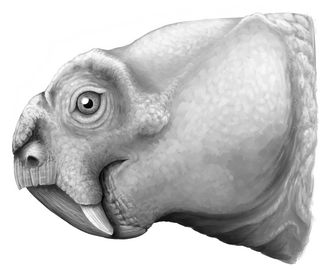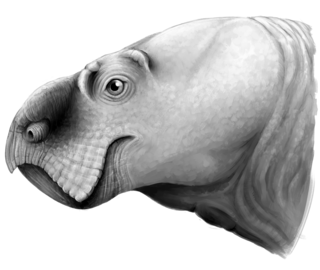
Kannemeyeria is a genus of dicynodont that lived during the Anisian age of Middle Triassic period in what is now Africa and South America. The generic name is given in honor of Daniel Rossouw Kannemeyer, the South African fossil collector who discovered the original specimen. It is one of the first representatives of the family, and hence one of the first large herbivores of the Triassic.

Sinokannemeyeria is a genus of kannemeyeriiform dicynodont that lived during the Anisian age of Middle Triassic period in what is now Shanxi, China.

Stahleckeriidae is a family of dicynodont therapsids whose fossils are known from the Triassic of North America, South America, Asia and Africa.

Dinodontosaurus is a genus of dicynodont therapsid. It was medium to large dicynodont of the Triassic and had a beak corneum. It lived in the Middle Triassic but disappeared in the Upper Triassic.
Angonisaurus is an extinct genus of kannemeyeriiform dicynodont from the Middle Triassic of Africa between 247 and 242 million years ago. Only one species, Angonisaurus cruickshanki has been assigned to this genus. This genus is thought to have been widely spread but rare in southern Gondwana. Though few in number, the fossil record of Angonisaurus cruickshanki contains multiple specimens giving it a measurable stratigraphic range. Sexually dimorphic features are found in Angonisaurus which include presence or absence of tusks and difference is size and robustness of the temporal arch and the rostral.
Elephantosaurus is an extinct genus of dicynodont from the Middle Triassic (Ladinian) Bukobay Formation. The holotype and only known specimen, catalogued as PIN 525/25, is a fragment of the skull that includes portions of the left interorbital region and nasal bones, and suggests a very large animal with a skull at least 30 centimetres (12 in) wide. The bones of the skull roof are also unusually thick. While usually considered a member of the Stahleckeriidae, generally due to its size, it probably falls just outside the group due to its frontal bone contributing substantially to the margin of the eye socket.
Sangusaurus is an extinct genus of large dicynodont synapsid with two recognized species: S. edentatus and S. parringtonii. Sangusaurus is named after the Sangu stream in eastern Zambia near to where it was first discovered + ‘saur’ which is the Greek root for lizard. Sangusaurus fossils have been recovered from the upper parts of the Ntawere Formation in Zambia and of the Lifua Member of the Manda Beds in Tanzania. The earliest study considered Sangusaurus a kannemeyeriid dicynodont, but more recent phylogenetic analyses place Sangusaurus within the stahleckeriid clade of Dicynodontia. Until recently, little work had been done to describe Sangusaurus, likely due to the fact that only four incomplete fossil specimens have been discovered.
Vinceria is an extinct genus of kannemeyeriiform dicynodont in the family Shansiodontidae. Fossils of the genus have been found in the Anisian Cerro de las Cabras Formation and Carnian Río Seco de la Quebrada Formation of Argentina. One species, V. argentinensis, named in 1966, was moved to its own genus, Acratophorus, in 2021. Another species, V. vieja, was merged with Acratophorus argentinensis in 2021, leaving V. andina as the only species in the genus.

Lystrosauridae is a family of dicynodont therapsids from the Permian and Triassic time periods. It includes two genera, Lystrosaurus and Kwazulusaurus. Kwazulusaurus includes a single species, K. shakai, from the Late Permian of South Africa and Lystrosaurus includes many species from the Late Permian and Early Triassic of South Africa, India, and Antarctica.
Shaanbeikannemeyeria is an extinct genus of dicynodont known from the Early Triassic of China. It contains a single species, S. xilougoensis, which was described in 1980 by Zheng-Wu Cheng from a skull catalogued as IGCAGS V315. The specimen was lost, and a neotype skull IVPP V 11674 was later designated. A second species, S. buergondia, was named by Jin-Lin Li in 1980 from a partial skeleton, but it has since been regarded as a synonym of S. xilougoensis.

Kannemeyeriiformes is a group of large-bodied Triassic dicynodonts. As a clade, Kannemeyeriiformes has been defined to include the species Kannemeyeria simocephalus and all dicynodonts more closely related to it than to the species Lystrosaurus murrayi.
Syops is an extinct genus of dicynodont therapsid. The type species S. vanhoepeni was first named in 1938 as Dicynodon vanhoepeni. Fossils of the genus have been found in the Cistecephalus Assemblage Zone in the Usili Formation of the Ruhuhu Basin, Tanzania and the Upper Madumabisa Mudstone Formation of the Luangwa Basin, Zambia. Its phylogenetic placement is somewhat uncertain, with multiple different studies finding it as either a basal geikiid, rhachiocephalid a dicynodontoid more derived than the most basal genera but less derived than Lystrosauridae, or a lystrosaurid.
Rhachiocephalidae is an extinct family of dicynodont therapsids. It includes two genera from the Late Permian of southern Africa, Rhachiocephalus and Kitchinganomodon. Rhachiocephalids were the largest dicynodonts in the Permian, although the kannemeyeriiform dicynodonts of the Late Triassic grew to larger sizes. Rhachiocephalids are also unusual in that they have long, low skulls.

Eubrachiosaurus is an extinct genus of stahleckeriid dicynodont known from the Late Triassic of Wyoming, United States.

Shansiodontidae is a family of dicynodont therapsids.
Sungeodon is an extinct genus of dicynodont therapsid from the Early Triassic of China. It is known from a single type species, Sungeodon kimkraemerae, which was named in 2014. Sungeodon is the earliest member of a group of dicynodonts called Kannemeyeriiformes, which would radiate later in the Triassic to become the dominant large herbivores of terrestrial ecosystems. Before its discovery no kannemeyeriiform dicynodonts were known from the Early Triassic. The presence of Sungeodon in the earliest Triassic Jiucaiyuan Formation indicates that dicynodonts diversified soon after the Permian-Triassic extinction event, mirroring the explosive radiations of other tetrapod groups such as archosaurs soon after the extinction.

Pentasaurus is an extinct genus of dicynodont of the family Stahleckeriidae, closely related to the well known Placerias. It was found in the Lower Elliot Formation of South Africa, dated to the Norian of the Late Triassic period. The genus contains the type and only species, Pentasaurus goggai. Pentasaurus is named after the ichnogenus Pentasauropus, fossil footprints that were originally described from the lower Elliot Formation in 1970 decades before the body fossils of Pentasaurus itself were recognised. Pentasauropus footprints were likely made by dicynodonts, and in South Africa Pentasaurus itself was the likely trackmaker. The name reflects the fact that a large dicynodont was predicted to have existed in the lower Elliot Formation before any body fossils were recognised, and so Pentasaurus was named after its probable footprints. This is a reversal of the more typical occurrence where fossil footprints are named after their presumed trackmakers. The name of the species honours its collector Alfred Brown, nicknamed "Gogga", which means "bug" in Afrikaans.

Repelinosaurus is an extinct genus of dicynodont from the Purple Claystone Formation of Luang Prabang in Laos, Southeast Asia that lived at around the time of the Permian-Triassic boundary and possibly dates to the earliest Early Triassic. Its type and only known species is R. robustus. Repelinosaurus was originally described as the earliest known kannemeyeriiform dicynodont, supporting the idea of a more rapid radiation of the Triassic kannemeyeriiform dicynodonts during the Early Triassic following the Permian mass extinction. However, it may alternatively be more closely related to the Permian Dicynodon. The discovery of a potential early kannemeyeriiform in an understudied locality like Laos highlights the importance of such places in dicynodont research, which has been largely focused on historically important localities such as the Karoo Basin of South Africa.

Ufudocyclops is an extinct genus of stahleckeriid dicynodont from the Middle Triassic of South Africa. It was found in the Burgersdorp Formation, part of the uppermost Cynognathus Assemblage Zone of the Beaufort Group in the Karoo Basin. The type and only known species is U. mukanelai. It was a large, beaked herbivore like other Triassic dicynodonts, lacking tusks, and is mostly characterised by unique features of the skull. It is known from three specimens, two of which were previously referred to the Tanzanian dicynodont Angonisaurus. The separation of Ufudocyclops from Angonisaurus indicates that the Middle Triassic fauna of the Beaufort Group in South Africa was not part of a larger shared fauna with those of the Manda Beds in Tanzania, as was previously supposed, and suggests that they were separated as more localised faunas, possibly by geographic barriers or in time. Ufudocyclops then would have been a unique part of the uppermost Cynognathus Assemblage Zone in South Africa. It is also the oldest known member of the family Stahleckeriidae, and implies that the family was already diversifying in the Middle Triassic alongside other kannemeyeriiforms, not just in the Late Triassic after other families died out.

Woznikella is an extinct genus of kannemeyeriiform dicynodont from the Late Triassic of Poland and possibly Germany of Europe. The type and only known species is W. triradiata.

















